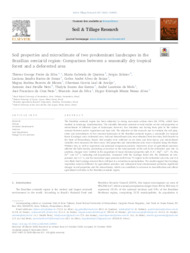Soil properties and microclimate of two predominant landscapes in the Brazilian semiarid region: comparison between a seasonally dry tropical forest and a deforested area.
Soil properties and microclimate of two predominant landscapes in the Brazilian semiarid region: comparison between a seasonally dry tropical forest and a deforested area.
Author(s): SILVA, T. G. F. da; QUEIROZ, M. G. de; ZOLNIER, S.; SOUZA, L. S. B. de; SOUZA, C. A. A. de; MOURA, M. S. B. de; ARAUJO, G. G. L. de; STEIDLE NETO, A. J.; SANTOS, T. S. dos; MELO, A. L. de; CRUZ NETO, J. F. da; SILVA, M. J. da; ALVES, H. K. M. N.
Summary: The Brazilian semiarid region has been subjected to strong man-made actions since the 1970s, which have resulted in landscape transformation. The scientific literature presents several studies on the soil properties or microclimate of different types of landscapes; however, less attention was having been paid to the surface contrast between native vegetation and bare soil. The objective of this research was to evaluate the soil properties and microclimate of two common landscapes in the Brazilian semiarid region, a seasonally dry tropical forest (Caatinga) and a deforested area. Soil and microclimate data were obtained from two sites, both located in the State of Pernambuco, Brazil. Soil samples were collected on six dates and from layers, and microclimate variables were measured for three years. Soil properties and microclimatic data were evaluated using the MannWhitney test, as well as regression and principal component analysis. Successive years of agricultural practices affected the bulk density, promoting an increase in the total porosity of the soil in the deforested area site. In addition, changes were verified in the magnitude of many chemical properties (pH, P, K+, Mg2+, Cu2+, Fe, Mn, Zn2+ and Ca2+), indicating soil degradation. Compared with the Caatinga forest site, the minimum air temperature was 2.3 ◦C, and the maximum vapor pressure deficit was 7% higher in the deforested area site, and it is very likely that Caatinga removal there will lead to a reduction in precipitation. The results suggest that Caatinga vegetation removal followed by agricultural practices and subsequent land abandonment promotes significant changes in soil properties and the microclimate, which can contribute to advances in desertification and affects agricultural activities in the Brazilian semiarid region.
Publication year: 2021
Types of publication: Journal article
Unit: Embrapa Semi-arid Region
Observation
Some of Embrapa's publications are published as ePub files. To read them, use or download one of the following free software options to your computer or mobile device. Android: Google Play Books; IOS: iBooks; Windows and Linux: Calibre.
Access other publications
Access the Agricultural Research Database (BDPA) to consult Embrapa's full library collection and records.
Visit Embrapa Bookstore to purchase books and other publications sold by Embrapa.

